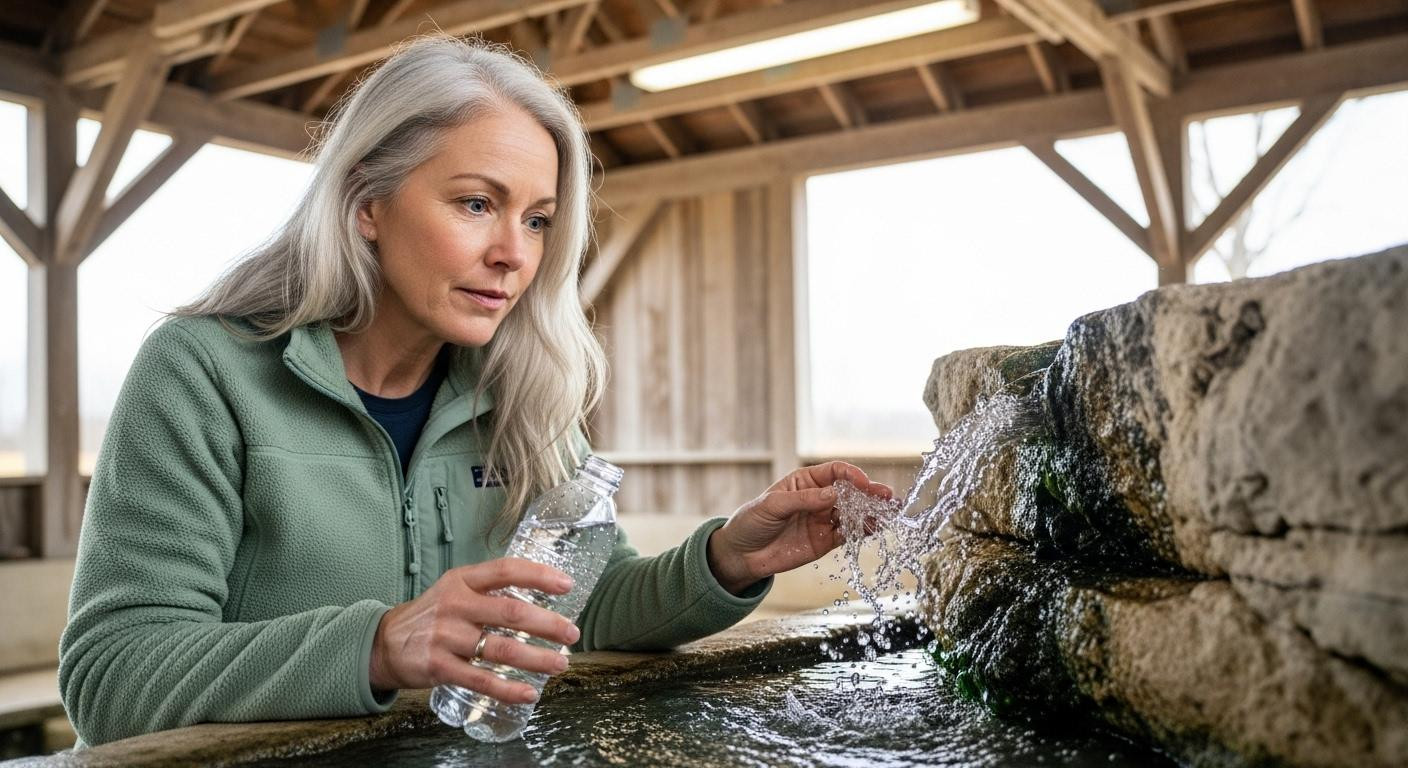Dawn at Hooper Springs Park, 6:47 AM. Mist rises from bubbling pools as naturally carbonated water surfaces through limestone exactly as it did when emigrants tasted it in 1838. They discovered bread dough rising without yeast from this mineral water. While Saratoga Springs charges $300 for mineral spa treatments, this 3,400-resident Idaho town protects free access to springs that transformed pioneer baking. The promise: understanding how geology, history, and sensory immersion converge to reshape your relationship with natural chemistry.
The oasis that bubbles without heat
Hooper Springs Park sits quietly one mile north of downtown Soda Springs. Water bubbles from limestone formations at a constant 60°F, creating visual confusion. The springs appear to boil yet feel cold to touch.
This phenomenon occurs at 5,350 feet elevation in southeastern Idaho’s Oregon Trail corridor. Underground CO2 reservoirs pressurize groundwater through ancient volcanic activity. The result: naturally carbonated springs that captivated emigrants for over 150 years.
Unlike Yellowstone’s geothermal geysers, these springs produce carbonation through chemistry, not heat. Similar to how Wallace, Idaho preserves mountain heritage, Soda Springs maintains authentic access to geological wonders.
What pioneers discovered in 1830 that science explains today
Emigrants documented “super carbonated water” fountains bubbling from limestone. They called the area “Beer Springs” for its effervescent qualities. Oregon Trail diarists noted water that tasted like artificial soda.
The chemistry emigrants documented but couldn’t name
In 1838, emigrant accounts described water “bubbling and foaming like boiling water” that proved “excellent for baking bread, no preparation necessary.” The carbonated water caused dough to rise without yeast addition.
Modern science explains this phenomenon. Ancient volcanic activity created underground CO2 deposits that dissolve into groundwater under pressure. When springs surface, dissolved carbon dioxide creates natural carbonation identical to commercial soda water.
The accidental geyser that erupts on schedule
In 1937, residents drilled for community bathing pool water. They hit a pressurized carbonated water reservoir instead. The accidental geyser shot 100 feet high for several weeks before being capped.
Today, the controlled geyser erupts hourly at precisely timed intervals. Like Dinosaur, Colorado’s geological identity, Soda Springs embraces its accidental natural wonder. Local tourism boards call it the world’s only captive geyser.
Tasting history at free spring houses tourists never find
The covered spring house at Hooper Springs offers direct access to carbonated water. Visitors bring cups and bottles daily, following a ritual locals have maintained for over 150 years.
The ritual 3,400 residents protect
Free access remains the community’s defining principle. No admission fees, no commercialization, no spa treatments. The spring water tastes citrus-like with mineral complexity from dissolved limestone.
Recent visitor surveys from 2025 show 85% surprise at the pleasant flavor. Many fill multiple bottles, exactly as Oregon Trail emigrants did. Similar to small Texas towns preserving authentic heritage, Soda Springs prioritizes accessibility over monetization.
Where Oregon Trail emigrants filled canteens
Historic trails wind through limestone formations surrounding multiple spring sites. Preserved markers identify Steamboat Spring, Octagon Spring, and the original Beer Springs locations emigrants documented.
Walking these paths connects visitors directly to 1830s-1860s pioneer experiences. The same water chemistry that leavened emigrant bread flows unchanged. Annual visitor estimates reach 45,000, yet the experience feels untouched by tourism.
The transformation that begins with bubbles
Tasting naturally carbonated water from pioneer spring houses shifts perspective profoundly. The direct sensory connection to geological time and frontier resourcefulness transforms how visitors understand authentic heritage tourism.
Unlike commercialized mineral destinations charging hundreds for spa treatments, Soda Springs demonstrates community values preserving natural access. Optimal timing strategies for visiting geological wonders apply perfectly here during late summer months.
The transformation occurs gradually. First taste surprises. Second cup reveals complexity. Third visit creates lasting connection to pioneer ingenuity and geological wonder.
Your questions about Soda Springs answered
How do I access Hooper Springs Park?
Located 1 mile north of downtown Soda Springs off Idaho Highway 34, the park opens daily year-round with free admission. Facilities include covered picnic areas and the historic spring house. Best visited August-October for optimal weather with 65-75°F days and minimal crowds.
Is the naturally carbonated water safe to drink?
Yes. Locals have consumed spring water for over 150 years without health concerns. The naturally carbonated water contains dissolved minerals including calcium and magnesium from limestone filtration. Many visitors bring bottles to fill, though the distinct mineral taste surprises first-timers expecting neutral flavors.
How does Soda Springs compare to commercial mineral spas?
Unlike Saratoga Springs’ $300 spa treatments or European commercialized springs, Soda Springs maintains completely free public access to natural carbonation. The town preserves springs as historical sites rather than tourist attractions, with 3,400 residents protecting accessibility over monetization for generations.
Morning mist lifts from Hooper Springs’ limestone pools at 7:45 AM as bubbles rise through water unchanged since emigrant visits. The soft mineral scent carries across sagebrush while your hand cups the same cold carbonated water that leavened pioneer bread. Time collapses through direct geological connection.
